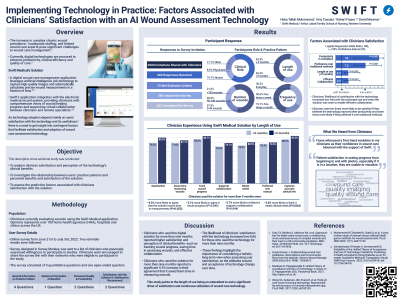Clinical Research
(CR-041) Implementing technology in Practice: Factors Associated with Clinician Satisfaction using an AI-Powered Wound Solution: Observational cross-sectional study
Friday, April 28, 2023
7:15 PM - 8:30 PM East Coast USA Time

Amy Cassata, RN, WCC – Vice President Clinical Success, Clinical Success, Swift Medical Inc.; Robert D. J. Fraser, RN, WCC – Director Clinical Success, Clinical Success, Western University; David Mannion, BA – Director Marketing Development, Marketing, Swift Medical Inc.
Introduction: With the high rates of clinician burnout and attrition in the healthcare system, understanding satisfaction with new resources designed to improve their work conditions is critical as the adoption level is vastly dependent on users’ satisfaction with the technology and its usefulness.1
Our observational cross-sectional study investigated the predictive factors associated with clinicians' satisfaction of a digital wound care application leveraging artificial intelligence technology.
Methods: Clinicians evaluating wounds using the wound care application, across the care continuum in the US, were invited to participate in an online survey. The survey questions gathered information on clinicians' practice patterns, satisfaction, and perspectives on the perceived benefits of using the technology.
Results: The majority (74.6%) of the surveyed clinicians were nurses, and 70.8% were frequent users. Our study demonstrated that clinicians using the application for a longer time experienced a greater level of satisfaction and perceived clinical benefits. Our findings noted a significantly higher satisfaction (85.5% vs. 76.5%, P=0.034) and agreement on received clinical benefits, such as tracking clinical changes in wound cases (88.7% vs. 83.6%, P=0.045), saving time in assessing wounds (81.1% vs.71.6%, P=0.023), and effective collaboration (76.1% vs. 70.4%, P=0.044), among those who used the solution for more than nine months compared to less than nine months of use.
Our empirical findings from logistic regression analysis suggest that clinicians who believed that technology improved their productivity were ten times more likely to be satisfied with the technology (OR 10.030, 95% CI 3.438- 10.259, P < 0.001). Moreover, the likelihood of clinicians' satisfaction with the technology increased two-fold with the prolonged use of technology (OR 2.334, 95% CI 1.940- 5.792, P = 0.042) and when the solution was seen as enabler of a more efficient collaboration with other providers (OR 2.291, 95% CI 2.928-5.656, P = 0.047).
Discussion: Clinicians' satisfaction with technology changes over time. This study demonstrates that a holistic understanding of what drives clinician satisfaction in practice is essential in addition to individual factors (e.g., perceived attitude and beliefs). The length of use complements beliefs and attitudes in evaluating end-users’ satisfaction with the wound care technology and its benefits.
Our observational cross-sectional study investigated the predictive factors associated with clinicians' satisfaction of a digital wound care application leveraging artificial intelligence technology.
Methods: Clinicians evaluating wounds using the wound care application, across the care continuum in the US, were invited to participate in an online survey. The survey questions gathered information on clinicians' practice patterns, satisfaction, and perspectives on the perceived benefits of using the technology.
Results: The majority (74.6%) of the surveyed clinicians were nurses, and 70.8% were frequent users. Our study demonstrated that clinicians using the application for a longer time experienced a greater level of satisfaction and perceived clinical benefits. Our findings noted a significantly higher satisfaction (85.5% vs. 76.5%, P=0.034) and agreement on received clinical benefits, such as tracking clinical changes in wound cases (88.7% vs. 83.6%, P=0.045), saving time in assessing wounds (81.1% vs.71.6%, P=0.023), and effective collaboration (76.1% vs. 70.4%, P=0.044), among those who used the solution for more than nine months compared to less than nine months of use.
Our empirical findings from logistic regression analysis suggest that clinicians who believed that technology improved their productivity were ten times more likely to be satisfied with the technology (OR 10.030, 95% CI 3.438- 10.259, P < 0.001). Moreover, the likelihood of clinicians' satisfaction with the technology increased two-fold with the prolonged use of technology (OR 2.334, 95% CI 1.940- 5.792, P = 0.042) and when the solution was seen as enabler of a more efficient collaboration with other providers (OR 2.291, 95% CI 2.928-5.656, P = 0.047).
Discussion: Clinicians' satisfaction with technology changes over time. This study demonstrates that a holistic understanding of what drives clinician satisfaction in practice is essential in addition to individual factors (e.g., perceived attitude and beliefs). The length of use complements beliefs and attitudes in evaluating end-users’ satisfaction with the wound care technology and its benefits.

.png)